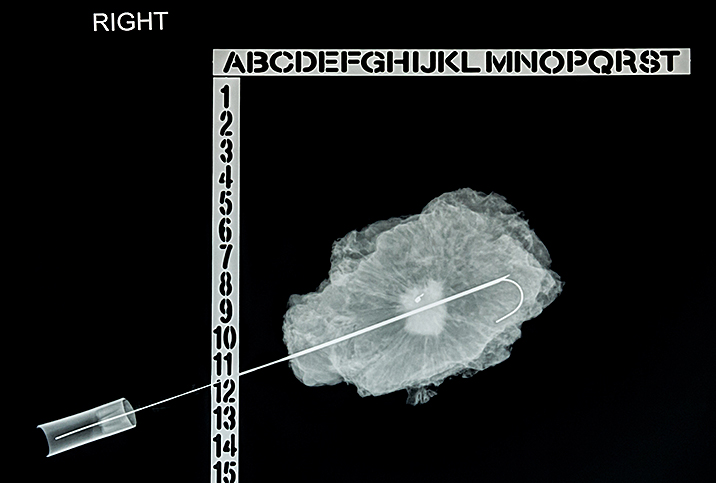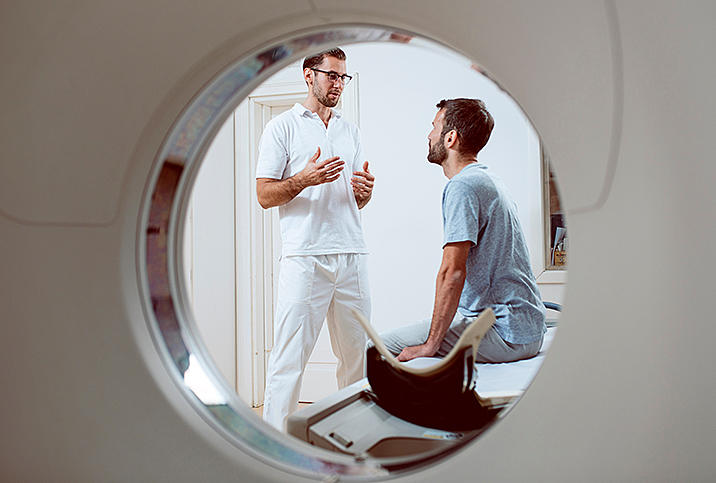What Is a Prostate Biopsy Like? One Man Shares His Experience

Not long after turning 50, Shane noticed he was urinating frequently. Too frequently.
"I like to drink about 80 ounces of water every day," said Shane, 52, a vice president of sales in Van Buren, Arkansas. "But it got to the point where I couldn't go two hours without peeing."
Frequent urination, besides being annoying, can be a sign of a range of conditions—some of them serious, some of them not. Among the serious possible causes of frequent urination is advanced prostate cancer, according to the American Cancer Society (ACS). In some cases that might necessitate a prostate biopsy.
What is prostate cancer?
Prostate cancer is a form of cancer that develops in the cells of the prostate gland, a small, walnut-sized organ located below the bladder in males. It is one of the most common types of cancer in men—1 in 8 guys will develop it—particularly older men, according to the Centers for Disease Control and Prevention (CDC).
Prostate cancer usually grows slowly and may not cause significant symptoms—or any—in its early stages. In its more advanced stages, it may cause symptoms such as pelvic pain, painful ejaculation and urinary problems, like the aforementioned frequent urination.
When Shane spoke with his primary care physician about his persistent urination, she recommended a prostate-specific antigen (PSA) test, a leading method for detecting prostate cancer.
What is a PSA test?
The PSA blood test measures prostate-specific antigen, a protein produced by both normal and malignant cells of the prostate gland that is always present in the blood. PSA levels tend to be elevated in men with prostate cancer, but PSA can be high for a number of other reasons, too.
Because it can vary from person to person, there’s no single normal or abnormal PSA level.
Generally speaking, however, the higher a man's PSA level, the higher his chance of having prostate cancer, according to the Prostate Cancer Foundation.
At his doctor's urging, Shane underwent the PSA test. His test results revealed he had a slightly elevated PSA level: 4.59 nanograms/milliliter. A PSA level between 4.0 ng/mL and 10 ng/mL indicates a 1 in 4 chance of having prostate cancer.
Since Shane's PSA levels were on the high side, his physician referred him to a urologist to have his prostate gland checked. A digital rectal exam uncovered nothing unusual. To be safe, however, the urologist recommended Shane undergo a prostate biopsy.
"I didn't have any other unusual signs, but they were just concerned about how much I was having to pee," he said. "That's why they chose to do the biopsy—to get a better idea of ruling anything else out they couldn't see or feel from all the exams and the conversations that I had with my urologist."
What is a prostate biopsy?
A prostate biopsy is a medical procedure performed to collect tissue from the prostate gland to examine it for signs of prostate cancer. It can be conducted either through the rectum or through the perineum (the space between the anus and the scrotum).
During the procedure, a urologist inserts a thin needle into the prostate gland to collect tissue samples. Multiple samples, usually 10 to 12, are collected from different regions of the prostate to increase the chances of detecting cancer, if it is present.
Most men do not find a prostate biopsy more than moderately painful and uncomfortable, and any side effects are usually not serious. Common complications of a prostate biopsy include the following:
- Pain in the perineum
- Blood in the stool and urine for a few days to a week
- Blood in the semen for up to six weeks or longer
How to prepare for a prostate biopsy
Considering the side effects and potential for unfavorable results, Shane was understandably apprehensive as he prepared for his prostate biopsy. Compared to the preparation for a colonoscopy, "Where you gotta drink all that nasty stuff," he said—the prep for a prostate biopsy was fairly straightforward.
"I didn't have to change my eating [like with a colonoscopy]. I could eat whenever I wanted, whatever I wanted," he said.
The only thing his urologist really recommended to get ready for the procedure was to perform a Fleet enema the night before the appointment. A Fleet enema is liquid medicine used to help relieve constipation and clean out the bowels before a procedure or surgery.
"It wasn't bad at all," Shane said of the Fleet enema.
What happens during a prostate biopsy?
The urologist began Shane's biopsy appointment by performing a digital rectal exam and conducting an ultrasound of Shane's prostate. Then, the doctor administered shots of Novocain, a local anesthetic, to numb the area around the prostate.
"Getting the Novocain shot was probably the part that hurt the most," Shane said.
Before beginning the biopsy, the urologist showed Shane the device he was going to be using to perform the procedure: a spring-loaded tool that rapidly inserts a needle through the rectum. The device is sometimes referred to as a biopsy gun because of the loud "click" sound it makes as it takes a sample.
"My doctor did a fantastic job explaining [what was going to happen]," Shane said. "He actually shot the gun [into the air] before he injected it in me so I would know what the sound was going to be like."
The urologist collected 12 tissue samples from Shane's prostate. Each time, before pulling the trigger to fire the needle into his prostate and draw out samples of the tissue, the doctor gave Shane a warning: "3, 2, 1, bang!"
"The first two really startled me, but once I got used to the sound, it wasn't that bad," he said. "I relaxed and it went much smoother after that."
The doctor and nurse chatted with Shane throughout the procedure, which he said helped make the time go faster. In about 10 minutes, the biopsy was over. Within 20 minutes of arriving at the office, he was driving home.
What is the recovery from a prostate biopsy like?
For a few days after the appointment, Shane took it easy—per the doctor's orders. As part of the recovery process, he was advised to avoid working out or lifting anything heavy for 48 hours after the appointment.
"The first evening, I was a little uncomfortable," Shane said. "But by the next morning, I didn't have a problem in the world."
In the days following the biopsy, Shane noticed a little blood in his urine. To this day, weeks after the procedure, he is still seeing blood in his semen—but he'd been warned to expect this.
"The nurse told me, 'You'll probably have blood in your semen for up to or longer than six months—so don't freak out,'" Shane said.
The results of Shane's prostate biopsy
A few days after the biopsy, the urologist's office delivered the good news: Shane's test results came up benign.
So what was the culprit behind his frequent urination? During the ultrasound that preceded the biopsy, the doctor discovered Shane's prostate was enlarged—"about twice as big as a normal prostate," he said.
Benign prostatic hyperplasia (BPH) is a common condition in men older than 50, and it usually isn't a threat to a person's health. An enlarged prostate does, however, push against the bladder, urethra and bladder muscles, often causing frequent urination and other urinary problems. In addition, an enlarged prostate can also drive up PSA levels.
Now, Shane is taking medication to reduce the frequency of his urination.
"It has helped, but I also have tried to tone down how much water intake I have every day," he said.
In several months, Shane will return to the urologist for another PSA test.
"At that time, if I don't feel like I'm where I want to be regarding how many times I urinate and based on my PSA levels, we can discuss options," he said.
Parting wisdom
When pressed to give advice to men who are apprehensive about a coming prostate biopsy, Shane said, "It's not as bad as you think."
In fact, the worst part about the whole experience—even worse than the Novocain shot—was the dread he felt leading up to the procedure.
"I got myself worked up about the whole situation and I was nervous and uncertain of what to expect," Shane said. "Once I finally relaxed, it was a lot easier."


















